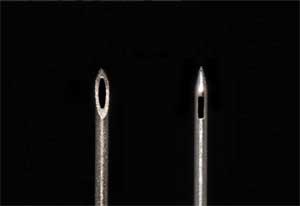- Home
- Editorial
- News
- Practice Guidelines
- Anesthesiology Guidelines
- Cancer Guidelines
- Cardiac Sciences Guidelines
- Critical Care Guidelines
- Dentistry Guidelines
- Dermatology Guidelines
- Diabetes and Endo Guidelines
- Diagnostics Guidelines
- ENT Guidelines
- Featured Practice Guidelines
- Gastroenterology Guidelines
- Geriatrics Guidelines
- Medicine Guidelines
- Nephrology Guidelines
- Neurosciences Guidelines
- Obs and Gynae Guidelines
- Ophthalmology Guidelines
- Orthopaedics Guidelines
- Paediatrics Guidelines
- Psychiatry Guidelines
- Pulmonology Guidelines
- Radiology Guidelines
- Surgery Guidelines
- Urology Guidelines
Spinal Tap Needle Type Impacts the Risk of Complications

The type of needle used during a lumbar puncture makes a significant difference in the subsequent occurrence of a headache, nerve irritation and hearing disturbance in patients, according to a study by Hamilton medical researchers.
As well, they found the pencil-point atraumatic needle with the better tip design has been available for about 70 years, but few physicians have been using it because they have not been aware of its benefits over the conventional beveled atraumatic needles.
The implications on clinical care are huge, says Dr. Saleh Almenawer, the senior author of the study and a neurosurgeon at Hamilton Health Sciences who worked with a team of researchers at McMaster University.
“There is a more than 50 percent reduction in the occurrence of headaches with the atraumatic needles, and also more than a 50 percent reduction in patient readmissions and return to emergency rooms for narcotics or blood patches.”
A lumbar puncture, commonly known as a spinal tap, is a regular medical procedure used to diagnose and to treat disease. Post-dural puncture headaches appear in about 35 percent of patients, sometimes causing debilitating pain that can lead to a return to hospital for painkillers or more invasive treatment.
The study published today in The Lancet says using atraumatic needles rather than conventional traumatic needles for lumbar punctures is just as effective and results in a significant decrease in complications such as the headaches.
“The two needles differ in how they penetrate the thick membrane, called the dura, surrounding the nerves,” said Almenawer.
He explained that the sharp edges of the tip of a conventional needle cuts its way through, while the tip of an atraumatic needle causes the tissue to dilate and contract around it. The tiny hole left in the dura by the atraumatic needle makes it significantly more difficult for cerebrospinal fluid to leak through, thus diminishing the frequency of headaches, readmissions and treatment.
The study pooled data from 110 clinical trials, with more than 30,000 participants in 29 countries across the past 28 years.
Atraumatic needles have been around for decades, but their use remains significantly limited, according to the researchers. They also found the atraumatic needles cost the same or up to three times as much as the more conventional type.
“Several surveys from around the world showed that only a fraction of physicians know atraumatic needles exist, and among those even a smaller portion use the atraumatic type,” said Almenawer.
“Lumbar puncture is a standard procedure, with thousands done every day around the globe by physicians of many specialties. Unfortunately, conventional needles created in 1890 are still the default in most hospitals around the world. This study provides convincing high-quality evidence for people to change to the atraumatic needles for a better patient care.”
An accompanying commentary on the research in The Lancet says the study points out “the practice needs to change”.
“Clinicians should start using atraumatic needles for lumbar punctures. We need to change practice,” said Diederik van de Beek and Matthijs Brouwer, two neurology professors of the University of Amsterdam.
There was no external funding for the study.

Disclaimer: This site is primarily intended for healthcare professionals. Any content/information on this website does not replace the advice of medical and/or health professionals and should not be construed as medical/diagnostic advice/endorsement or prescription. Use of this site is subject to our terms of use, privacy policy, advertisement policy. © 2020 Minerva Medical Treatment Pvt Ltd